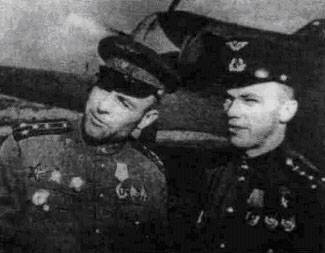
Aviation of World War II


 |
Aviation of World War II |


|
|
Soviet Union | Lend - Lease | Facts | Forum | Germany | Japan | R A F | U S A A F | Other | Photos |
|
Facts | People | Engines | Aces | Aircraft Handbook | WWII Periodicals | Contact | |
Ivan Kozhedub and La-7

The commander of the 176th GIAP Colonel P.E. Chupikov (left) and the deputy regiment commander Captain I.N. Kozhedub (right).
Kozhedub fought one of the most memorable battles on February 19, 1945 (sometimes the date is February 24). On this day, he flew out on a free hunt, paired with Dmitry Titarenko. On the traverse of the Oder, the pilots noticed a plane approaching rapidly from the direction of Frankfupt an der Oder. The plane flew along the riverbed at an altitude of 3500 m at a speed much higher than the La-7 could develop. It was the Me-262. Kozhedub instantly made a decision. The Me-262 pilot relied on the high-speed qualities of his car and did not control the airspace in the rear hemisphere and below. Kozhedub attacked from below on a head-to-head course, hoping to hit the jet in the belly. However, before Kozhedub, Titarenko opened fire. Much to Kozhedub's surprise, the slave's premature firing was beneficial. The German turned to the left, towards Kozhedub, the latter could only catch the Messerschmitt in the sight and press the trigger. Me-262 turned into a fireball. Non-commissioned officer Kurt-Lange from 1./KG(J)-54 was in the cockpit of the Me 262. On the evening of April 17, 1945, Kozhedub and Titarenko performed the fourth combat sortie of the day to the Berlin area. Immediately after crossing the front line north of Berlin, the hunters discovered a large group of FW-190s with suspended bombs. Kozhedub began to climb to attack and reported to the command post about the establishment of contact with a group of forty Focke-Wulwof with suspended bombs. German pilots clearly saw how a pair of Soviet fighters went into the clouds and did not expect them to appear again. However, hunters appeared. From behind, from above, Kozhedub in the first attack knocked down the leading four of the Fokkers, closing the group. The hunters tried to give the enemy the impression of the presence of a significant number of Soviet fighters in the air. Kozhedub threw his La-7 right into the midst of enemy aircraft, turning Lavochkin left and right, the ace fired in short bursts from the cannons. The Germans succumbed to the trick - the Focke-Wulfs began to free them from bombs that interfere with an air battle. However, the Luftwaffe pilots soon established the presence of only two La-7s in the air and, taking advantage of the numerical advantage, took the guardsmen into circulation. One FW-190 managed to get into the tail of Kozhedub's fighter, but Titarenko opened fire before the German pilot - the Focke-Wulf exploded in the air. By this time, help arrived - a La-7 group from the 176th regiment, Titarenko and Kozhedub were able to get out of the battle on the last remnants of fuel. On the way back, Kozhedub saw a single FW-190, still trying to drop bombs on the Soviet troops. Ace dived and shot down an enemy plane. This was the last, 62nd, German aircraft shot down by the best Allied fighter pilot. Kozhedub's total bill does not include at least two aircraft - American P-51 Mustang fighters. In one of the battles in April, Kozhedub tried to drive away German fighters from the American Flying Fortress with cannon fire. The US Air Force escort fighters misunderstood the intentions of the La-7 pilot and opened barrage from a long distance ... Glossary | Sources | People and Aircraft People of War | Chkalov & I-180 | Devyatayev & He-111 | Golodnikov & P-39 | Klubov & P-39 | Kovachevich & P-39 | Dudnik & LaGG-3 | Alekseev & La-5 | Gorelov & La-5 | Shvaryov & La-5 | Kozhedub & La-7 | Bystrykh & Pe-2 | Litvyak & Yak-1 | Eremin & Yak-3 | Mikoyan & Yak-1 | Klimenko & Yak-7 | Safonov & I-16 | Skachkov & Yak-7 | Suzi & I-180 | Sinaisky | |